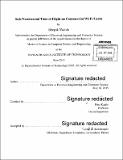Sub-nanosecond time of flight on commercial Wi-Fi cards
Author(s)
Vasisht, Deepak
DownloadFull printable version (5.079Mb)
Other Contributors
Massachusetts Institute of Technology. Department of Electrical Engineering and Computer Science.
Advisor
Dina Katabi.
Terms of use
Metadata
Show full item recordAbstract
Time-of-flight, i.e., the time incurred by a signal to travel from transmitter to receiver, is perhaps the most intuitive way to measure distances using wireless signals. It is used in major positioning systems such as GPS, RADAR, and SONAR. However, attempts at using time-of-flight for indoor localization have failed to deliver acceptable accuracy due to fundamental limitations in measuring time on Wi-Fi and other RF consumer technologies. While the research community has developed alternatives for RF-based indoor localization that do not require time-of-flight, those approaches have their own limitations that hamper their use in practice. In particular, many existing approaches need receivers with large antenna arrays while commercial Wi-Fi nodes have two or three antennas. Other systems require fingerprinting the environment to create signal maps. More fundamentally, none of these methods support indoor positioning between a pair of Wi-Fi devices without third party support. In this thesis, we present a set of algorithms that measure the time-of-flight to sub-nanosecond accuracy on commercial Wi-Fi cards. We implement these algorithms and demonstrate a system that achieves accurate device-to-device localization, i.e. enables a pair of Wi-Fi devices to locate each other without any support from the infrastructure, not even the location of the access points.
Description
Thesis: S.M., Massachusetts Institute of Technology, Department of Electrical Engineering and Computer Science, 2015. Cataloged from PDF version of thesis. Includes bibliographical references (pages 49-52).
Date issued
2015Department
Massachusetts Institute of Technology. Department of Electrical Engineering and Computer SciencePublisher
Massachusetts Institute of Technology
Keywords
Electrical Engineering and Computer Science.